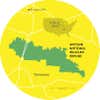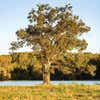A Stand in the Valley: Deer Hunting The Hatchie National Widlife Refuge
An archery hunt in the riverbottoms of west Tennessee proves there's still tremendous public deer hunting for anyone willing to work for it


That buck wasn’t supposed to be standing there. Not in a beanfield an hour after sunrise in October—on Tennessee public land. I have a game warden buddy in the Volunteer State who says Southern deer are so notoriously wary because, in this part of the world, “critters get got after.” Yet, here he was—a heavy, potbellied 8-pointer standing there as if he lived on 1,000 private acres in Iowa. He wasn’t 200 yards from where I’d parked the truck, and I would’ve had a chance of killing him had I brought my bow. Unfortunately, I was just holding binoculars, scouting ahead of a hunt the following week. I could hardly wait to come back.

Bottoms Up
I was on the Hatchie National Wildlife Refuge in southwest Tennessee. Most of the refuge is pristine hardwood bottomland forest, the type of habitat that once dominated the region called the Mississippi Alluvial Valley (MAV), which follows the lower Hatchie River from southern Illinois to the Gulf of Mexico. Today, only 20 percent of the MAV’s original forest remains. The rest has been cleared for farming.
The tributary stream coursing along the northern boundary of the refuge is the only one in western Tennessee that has never been impounded or channelized. That means the refuge floods often, as nature intended. It’s managed primarily to provide wintering habitat for waterfowl, but it’s not just a big duck hole. A cooperative program between the refuge and local farmers provides hundreds of acres of corn and soybeans, of which a good portion is left standing. The woods teem with a variety of oak species, too, several of which were dropping a bumper crop of acorns during my hunt. The whole place is simply fine whitetail habitat.
What’s it cost to hunt it? You’ll need to book a motel room, since camping isn’t allowed, as well as buy the required Tennessee hunting licenses and obtain and sign a regulations pamphlet from the refuge office. Aside from that, show up during archery season and go hunting for free in unspoiled country. Mature bucks live here, and your chances of at least going home with venison in the cooler are outstanding. If you require more out of a deer hunt, you’re difficult to please.

The Long Haul
Bowhunting the refuge will throw you a curveball if you’re accustomed to hill-country funnels because, at first glance, it all seems pancake flat. Trail cameras aren’t allowed; this is old-school deer hunting, with the scouting done on foot and the hunting done with a climbing stand on your back (stands cannot be left overnight). Fortunately, there are plenty of tall, straight trees and lots of deer to leave sign.
While scouting, I used the OnX Hunt app extensively, which provides satellite views, boundary locations, and topo lines. Even in a riverbottom, there are slight elevation changes and, if you really look, some small but genuine hills. Find those, in addition to feeder creeks and hidden oxbow lakes within the timber, and you’ll find the subtle edges that direct deer traffic.

I planned to hold out for the buck I had seen while scouting or one of his caliber, but I was here for meat, too. Mature does would be in trouble, particularly since you can kill three per day in this part of Tennessee. The weather was classic late October, and yet four sits in, I’d seen only a handful of deer, and none in crossbow range. No matter. I just needed to adjust.

On the third evening, I left my truck early and hiked a quarter mile beyond where I had been hunting, deeper into the bottoms until I came to a little hidden bank of short hills laced with oaks, maples, hickories, beech trees, and deer trails. I had picked up the feature on the topo map, and it was surrounded by a near impenetrable thicket. Yet, 20 feet up a straight pignut, I could see 40 yards in three directions. You don’t need a camera to tell you a spot like that will be good.

The squirrels were loud, almost obnoxious, but an hour before dark I heard footsteps of a difference cadence. A deer slipped along the edge of the thicket on my left. I saw legs first, then a big doe emerged 35 yards away. I didn’t waste time. I heard the arrow smack, and knew she wouldn’t make it far. She was the head of a line, as other deer exploded from the thicket in a flurry of white flags.
I gave the woods a minute to settle, cocked my crossbow, and made three lost-fawn bleats. More footsteps followed. Two does trotted into my best shooting lane, ears perked. I heart-shot the second one, and saw the deer crash 40 yards away. I allowed myself to shiver from the action and the evening chill. That shiver was why I had come here.


The extra distance I’d hiked in seemed double coming out—dragging one doe behind me on a rope and with the quarters of the other lashed to my pack. But the sweat washed off easy enough. I loaded the deer into my truck, switched off my headlamp, and sat there in the dark, guzzling a bottle of water and looking out across the blackness of the refuge. I was alone—and realized, in fact, that I hadn’t seen another hunter all week.
I didn’t get a chance at that buck, but I remember him, and that’s enough reason to go back. It is true: Southern critters do “get got after.” I’m glad for places like this, where anyone who’s willing to hunt can still get after them.